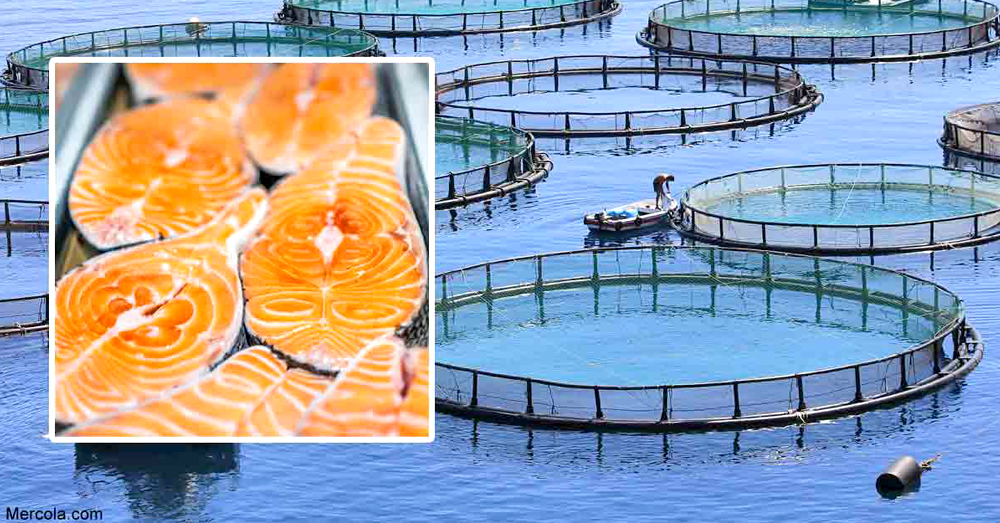
Farmed Salmon = Most Toxic Food in the World
Fish are an important part of the ecosystem and the human diet. Unfortunately, overfishing has depleted many fish stocks, and the proposed solution — fish farming — is creating far more problems than it solves. Not only are fish farms polluting the aquatic environment and spreading disease to wild fish, farmed fish are also an inferior food source.
July 25, 2018 | Source: Mercola.com | by Dr. Joseph Mercola
Fish are an important part of the ecosystem and the human diet. Unfortunately, overfishing has depleted many fish stocks, and the proposed solution — fish farming — is creating far more problems than it solves. Not only are fish farms polluting the aquatic environment and spreading disease to wild fish, farmed fish are also an inferior food source, in part by providing fewer healthy nutrients; and in part by containing more toxins, which readily accumulate in fat.
Farmed Salmon = Most Toxic Food in the World
Salmon is perhaps the most prominent example of how fish farming has led us astray. Food testing reveals farmed salmon is one of the most toxic foods in the world, having more in common with junk food than health food.1 Studies highlighting the seriousness of the problem include:
• A global assessment2 of farmed salmon published in 2004, which found 13 persistent organic pollutants in the flesh of the fish. On average, polychlorinated biphenyl (PCB) concentrations in farmed salmon was eight times higher than in wild salmon, prompting the authors to conclude that “Risk analysis indicates that consumption of farmed Atlantic salmon may pose health risks that detract from the beneficial effects of fish consumption.”
The International Agency for Research on Cancer and the Environmental Protection Agency classify PCBs as probably carcinogenic.
According to the U.S. Centers for Disease Control and Prevention, PCBs elicit a significant number of health conditions in animal studies, including cancer, immunosuppression, neurotoxicity and reproductive and developmental toxicity.3 Disturbingly, research suggests contaminated fish is the most common source of PCB exposure, as the chemicals accumulate and build up in the fat tissue.4
• A 2005 investigation5 by another group of scientists concluded even relatively infrequent consumption of farmed salmon may be harmful to your health thanks to the elevated dioxinlevels in the fish.
• Toxicology researcher Jerome Ruzzin, who has tested a number of different food groups sold in Norway for toxins, discovered farmed salmon contain five times more toxins than any other food tested. (In light of his own findings, Ruzzin has stopped eating farmed salmon.)
• A 2011 study6 published in PLOS ONE found chronic consumption of farmed salmon caused insulin resistance, glucose intolerance and obesity in mice, thanks to the persistent organic pollutants (POPs) found in the fish.
According to the authors, “Our data indicate that intake of farmed salmon fillet contributes to several metabolic disorders linked to Type 2 diabetes and obesity, and suggest a role of POPs in these deleterious effects. Overall, these findings may participate to improve nutritional strategies for the prevention and therapy of insulin resistance.”
Researchers Warn Farmed Salmon May Contain Fire Retardant Chemicals
Now, researchers warn7,8 farmed Atlantic salmon sold in the U.S. and U.K. may also contain polybrominated diphenyl ethers (PBDEs), toxic POPs that have been restricted or banned in the U.S. and many European countries due to their toxic influence on child development.9 As reported by The Star,10 “[A] new study by the University of Pittsburgh has found evidence of PBDEs in food fed to farmed salmon — even in those in supposedly PBDE-free environments.”
PBDEs are a class of chemicals that for years were used as flame retardants, and while restrictions were placed on some of the chemicals in this class in 2004, they can still be found in older products — and in the environment. China, Thailand and Vietnam — three areas that process significant amounts of electronic waste — are known to have higher levels of PBDEs in the environment.
In more recent years, flame retardant pollution has raised serious concern, as these chemicals build up in the environment over time and are in many areas now found in both ground water and open waters.
Health risks associated with these chemicals, including PBDEs, include infertility, birth defects, neurodevelopmental delays,11 reduced IQ,12 hormone disruptions13 and cancer. In fact, flame retardant chemicals have been identified as one of 17 “high priority” chemical groups that should be avoided to reduce breast cancer.14,15
